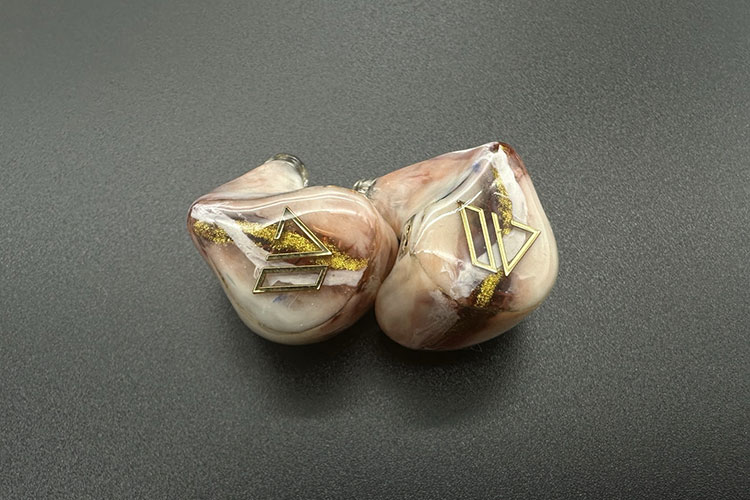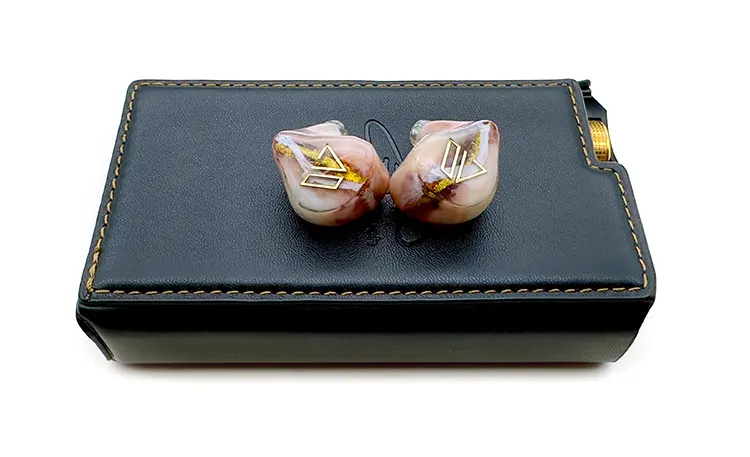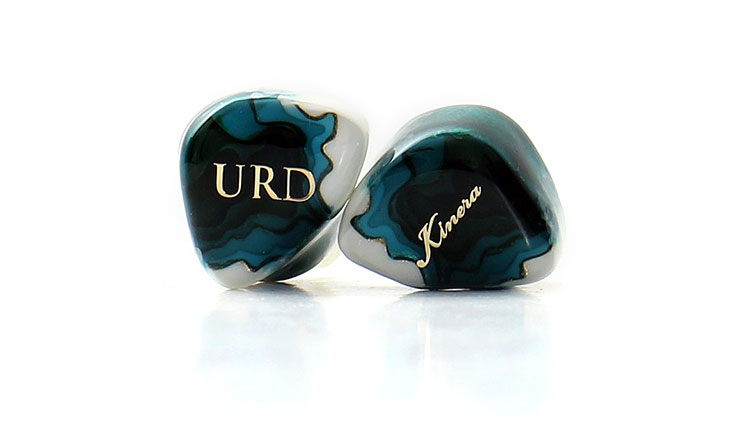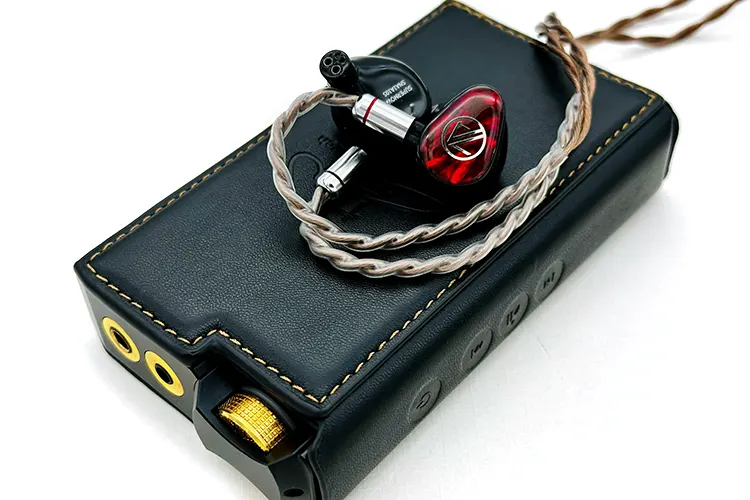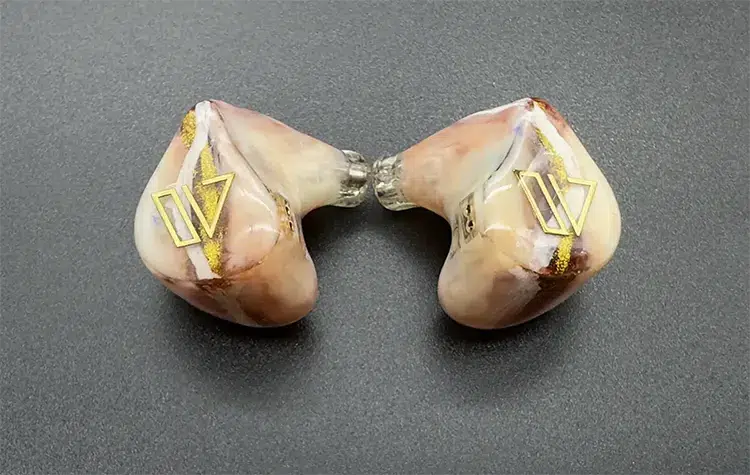Synergy
Ra has an impedance of 28Ω @1kHz and a sensitivity rating of 105 dB/Vrms.
This IEM needs a good amount of juice to fire up properly. Smaller devices such as dongles and smartphones cannot do justice to the output of Ra. A good and powerful source, such as Lotoo Paw Gold Touch, takes nearly 12-15 volume levels more than usual IEMs.
On some occasions, I tested Ra with the Earmen Angel, an even more powerful source, and observed the Angel opening up the IEM quite well and improving the dynamics.
The near-bright character of the Angel also adds a bit of airiness to the sound and makes it a good pair-up. Additionally, even with more power, there is no hiss or waterfall in the background.
Select Comparisons
Kinera URD
Technical
The Kinera URD is a multi-driver electrostatic hybrid universal IEM. The iem has a driver configuration of 2 dynamic drivers, 1 Kinera customized BA driver, and 2 Sonion electrostatic drivers.
Both the URD and the Ra have upper frequencies that are being managed by electrostatic drivers.
the URD has an impedance of 20Ω and a sensitivity of 107 dB @1kHz/Vrms which makes it more efficient on lower power compared to the Ra. The URD is easier to drive but can scale with additional power to sound more open and mature.
Design
As with the Ra, the URD shells are also made from high-grade resin and are hand-painted. The shells are of similar size, with URD having longer nozzles. The fit on the URD is as comfortable as with the Ra, however, the URD does stick out more on my ears.
URD connects with a 0.78mm 2-pin connector with a stock modular cable terminated with multiple plug options including a 4.4mm balanced, an SE 3.5mm, and a TRSS 2.5mm plug.
Kinera offers a notably enhanced and more sophisticated presentation, evident in its packaging. The box is more organized meaning the URD has a better unboxing experience than Ra.
Performance
The URD and the Ra both have good bass performances. While the bass on Ra is more about a more refined approach and more emphasis on sub-bass, the bass on URD is of thick and heavy character though not boomy.
I like how the bass on both IEMs has been tamed properly so as not to interfere with the higher frequencies. With better layering and texture of bass, Ra has an edge. Its bass is more enjoyable if you are looking for a well-defined and textured low-end response.
The Ra and URD have a similar mids presentation. The lower mids on both get a decent body and tonal weight from the bass region. The upper mids on URD have more energy than those on Ra. URD has a bit more lushness and richness in the midrange.
Both the URD and Ra use two EST drivers to handle their upper frequencies. Both of these IEMs have a very calm and controlled upper frequency without showing a bright character. The treble region has more energy and extension on URD.
The URD has more staging width than the intimate nature of Ra. Both of these IEMs are nearly as good in terms of resolution and detailing. the URD, because of a better treble extension, can be considered a touch more resolving.
7th Acoustics Supernova
Technical
7th Acoustics is an Indonesian boutique iem maker and the brand released the Supernova in early 2022. Supernova is a universal IEM with a 6 BA driver configuration using a mix of Sonion and Knowles drivers.
Supernova has an impedance of 15Ω but with no official SPL rating. That being said, this IEM is quite efficient to drive and does not need as much gain as the Ra.
Design
As with Ra, the Supernova shells are also built with resin, and the faceplates can be chosen from an array of available colors and designs.
The shells of the Supernova are a bit smaller and weigh nearly the same as those of the Ra. In terms of comfort, these IEMs have good ergonomic designs and fit well.
This cable is a high-quality braided copper cable with a 4.4mm termination. I do find that the Supernova stock cable has a better level of quality and a firmer character but you have to remember I am assessing the older Ra cable, not the new one.
Performance
The Supernova boasts a very natural and organic timbre with a noticeable mid-bass-focused sound and a warm midrange. The sub-bass does not have much emphasis. Bass on the Ra is a lot more enjoyable and has a better definition and quality.
The midrange is where Supernova excels the most. The lower midrange gets a decent weight and body from the bass boost. The vocals are quite natural and have a very nice texture.
The sounds from piano and string instruments are a lot more enjoyable on Supernova. However, there is sometimes a noticeable lack of resolution, and detailing and clarity are missing at times.
The treble on Supernova is quite relaxed and smooth with a lower treble tuning that has a very controlled nature. It does not have any sense of peakiness or sharpness.
This makes the Supernova quite ideal for relaxed listening. The upper treble region has more energy and extension than Ra, and there is a greater sense of airiness. The Supernova is above average in most of the staging parameters sounding wider and more spacious when compared to the Ra.
ORIVETI OH700VB
Technical
The ORIVETI OH700VB is a hybrid iem from ORIVETI that packs six BA drivers (2 for high, 4 for mid) and a dynamic driver for low frequencies.
It has an impedance of 12Ω and a sensitivity of 112 dB @1kHz/Vrms. The OH700VB is much easier to drive than the Alpha Omega Ra.

Design
The shells of OH700VB are made of resin, the same material that is on Ra. ORIVETI does not provide any customization options on this IEM.
The shells of OH700VB are a bit smaller than Ra and are lighter too though they do come with an additional bass switch for adjusting the low-end performance, a feature that the Omegon MK2 offers.
The OH700VB has a very good fit with lightweight shells that make it comfortable for longer listening sessions.
The cable that comes with OH700VB is a modular cable with interchangeable options for SE 3.5mm and 4.4mm terminations. The sonic quality of this cable is nearly comparable to that of Ra.
In terms of presentation, the OH700VB has better packaging and gives a better unboxing experience. There is a decent variety of ear tips available with the OH700VB.
Performance
The OH700VB shares many similarities with the Alpha Omega Ra. Both IEMs offer fairly comparable bass definitions, prompting this comparison.
When the bass switch is activated on the OH700VB, the quantity of bass closely mirrors that of the Ra. However, where the Ra distinguishes itself is in its superior bass quality.
The Ra exhibits a more refined layering and texture in its bass. Additionally, the Ra excels at rendering basslines from various sources more accurately, ensuring clearer distinction and separation.
The midrange on both IEMs has a lot of commonality. However, I find the mids on OH700VB a little bit sweeter and more natural sounding. The notes have a touch more weight, with better resolution and clarity. However, this difference is just subtle.
The treble on OH700VB has a bit of extra energy and a better sense of airiness. The soundstage is wider on the ORIVETI, and it sounds more open. The depth of the soundstage is a lot better on Ra.
Our Verdict
I must commend Alpha Omega for successfully executing a tribrid IEM design. It’s truly impressive, especially considering the relatively young age of the brand.
The Alpha Omega Ra has been a delightful surprise for me. Priced at under $600, it packs a considerable number of drivers and is tuned very well. The bass performance on the Ra is particularly noteworthy, exhibiting excellent quality and almost setting a benchmark.
Moreover, the design of the shell brings a refreshing change. This makes it an ideal companion for long, relaxed listening sessions, especially for those who enjoy a bit of fun in their audio experience. Ra is surely fun and pleasant to listen to.
Alpha Omega Ra Specifications
- Driver: 7 Drivers (1DD + 4 Sonion BA + 2 Sonion Electrostatic Drivers)
- Sensitivity: 105db
- Impedance: 28 Ohm
- Cable: 4 Core Gold Plated Copper Cable
- Connector Type: 0.78mm 2-pin.
- Termination Plug: 4.4mm Single-Ended Termination.

